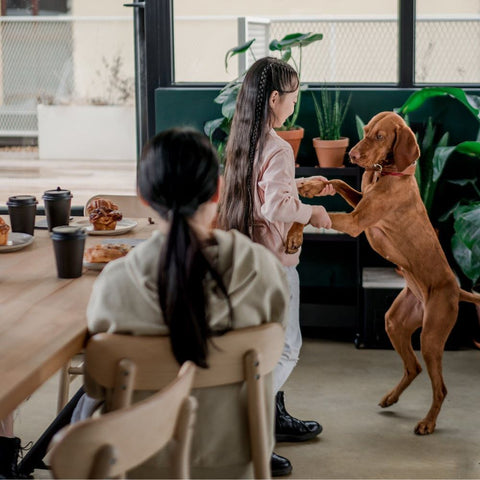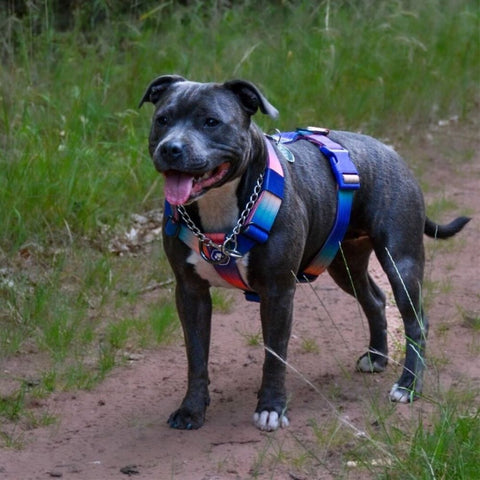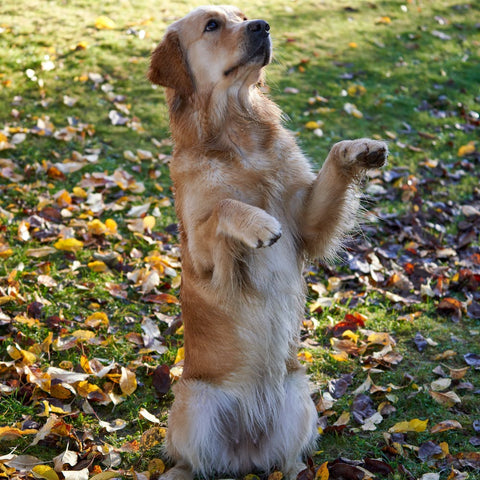Making Sense of Dog Leg Anatomy
Did you ever wonder as a child, why are my dogs knees backwards? What are paw pads made of? Why do dogs sit on their haunches, unlike people?
As you’ve grown older, you probably know better, but the clear answers to these questions may still have eluded you, or maybe you just want more details, such as ‘Why do so many dogs suffer from hip problems?’ or you’re concerned about a potential injury.
Anatomy can be complicated, but once you understand the basics, it's not too bad.
The Bones
Dogs are digitigrade animals, which is a fancy way of saying that they walk on their toe bones (Phalanges). Dog leg bone anatomy is very similar to human legs in terms of bone structure, they just happen to use the bones differently than we do.
For example, humans walk on both our ‘toe bones’ and our ‘foot bones’ whereas dogs only walk on their toe bones. Therefore, that weird backwards knee is actually your dog’s ankle joint![1] This is the same reason many birds and four-legged mammals also have ‘backwards knees’ on their hind legs.
The knee joint, or ‘stifle joint’ as it's known in dogs, sits much higher on a dog’s hind legs, and they tend to have short femurs (thigh bones). It may look like a dog has a continuous thigh, but they have a femur bone as well as fibula and tibia to make up their shin bones.
There is also a bump on the back of this ankle called a ‘Hock’ which acts as a heel and is where your dog’s achilles’ tendon connects.
The front legs have a similar structure to a human arm, with dogs walking on their ‘fingers’ and the balls of their ‘palms’.
There are three main bone sections on their front legs. These include the radius and ulna bones, making up the forearm, the short humerus bone making top of the leg, and the scapula, or shoulder bone, connecting your dog’s leg onto the spine and ribcage.
Paws, on both the front and hind legs, also contain two smaller sets of phalange bones. One group that makes up the individual toes, and another that connects the toes to the ‘wrist’.
On the front legs, you may also find a small bone protrusion that makes up the carpal pad. The carpal pad is that small piece of paw tissue that sits slightly higher up your dog’s leg.
You can see the image below for a rough look at the major bone groups.
First Aid for Fractures
While joint issues are the more common dog leg injuries, many dogs suffer from leg fractures when roughhousing or if they have been struck by a car. This is very painful, and the limping and lameness is normally noticeable.
This is an emergency and should be treated by a vet.
Dr. Michael Kearley, who has more than 10 years qualified veterinary experience has this to say about first aid for fractures: “The fracture needs to be supported properly and the dog confined. Attempting to reduce the fracture yourself is not recommended and can certainly make matters worse. The first thing to do is to move your dog gently and safely out of harm’s way while doing your best not to manipulate the fracture.”[2]
Vets will normally stabilize the broken bone, which may require surgery, and bind it to prevent the bone from moving. Healing from a bone fracture takes between 3 - 4 months on average. It is rare, but very complex fractures may result in amputation.
The Joints
Joints are all made up of the same components. They are the area where two or more bones meet. Bones in a joint are normally connected by tough bands of fibrous connective tissue called ligaments. Many joints are also connection points for muscles. Muscles connect to bones through fibrous connective tissue called tendons.
Both ligaments and tendons are easily injured in accidents and can result in a lot of pain and mobility loss. Joints are also responsible for a lot of movement.

Pexels/Ron Lach
The Hind Leg
Rear legs and their joints take a lot of wear and tear in active dogs, and many breeds suffer from hip and knee problems as they get older.
The hip joint in dogs is similar to the hip joint in humans. It is a ball-and-socket joint with the top of the femur (leg bone) being capped off with cartilage to allow for easy and smooth movement of the rear legs.
Hip dysplasia, a common genetic health issue in dogs, is when the dog’s hind legs become lame and painful from their hip sockets becoming too loose. It is one of the most common causes of dogs’ hind leg pain. There is no cure, but it can be better managed if the dog has healthy bones and a normal body weight.
Another common issue in the rear legs of dogs is issues with the stifle joint, which is what the knee joint is called in dog leg anatomy.
The stifle joint can be found on both rear legs and is where the femur connects to the lower leg. It contains a patella, or ‘knee cap’, as well as two sets of ligaments. The lateral collateral ligament - which provided stability in the joint, as well as the cranial cruciate ligament - which connects the two bones directly.
This is a complex joint, the synovial joint being one of the most important joints for movement, and is normally the target for a number of common ligament injuries. Dr. Robert Radasch of Dallas Veterinary Surgical Center confirms that “stifle injuries are the most common cause for rear limb lameness in the adult dog” and that treating them is a priority. [3]

In a paper Dr. Radasch co-wrote [3], he goes on to say that cranial cruciate ligament tears are one of the most common types of dog leg injuries, and that a lack of treatment can cause instability and degeneration in the stifle joint. This could result in permanent injury or arthritis after some time.
Another common injury is injuries that move the patella out of the way or damage the joining ligaments.
Many times a ligament injury will require surgery to reattach to the bone, or to stitch up a tear. Always go to your vet if you notice a significant limp as prompt care can make a big difference.
You can help your dog with its hind leg problems by going on shorter, more frequent walks, taking your dog swimming to relieve pressure on the joints, and gently playing tug-of-war to strengthen the hind legs.
There is also a joint in the ankle, and one that makes up the toe joints. They are also largely made of ligaments and short bones and are rarely prone to injury.
The Front Leg
Front leg joint injuries are much less common than hind leg injuries, but sometimes an unlucky accident can still cause some problems.
Like humans, a dog’s elbow is a hinge joint, meaning it can only really move up and down. Ligaments attach the bicep muscle to the joint and allow the dog to lift its leg.
Unlike humans, the scapula, or shoulder bone, sits more forward on your dog’s body. Placing your hand on the area behind your dog’s neck should let you feel their location. However, there are a lot of muscles that attach them to the neck and back, sometimes making them difficult to find.
It is a wide, scoop-shaped, triangular bone that glides over your dog’s ribs, allowing them to get a full range of motion when running. Injury is uncommon, as it normally takes a severe trauma, such as being hit by a car, to cause problems.

Pexels/Barnabus Davoti
The wrist is the most commonly injured joint on the front legs, as it has a lot of tendons and ligaments and is easily injured when dog’s jump from a height or onto hard ground.
The Paws
Each paw on a dog’s front and hind feet comes with a number of joints.
Paws normally have four carpal, or finger/toe bones, that join to the wrist/ankle. Even the hind foot is made up of multiple bones. Each of these carpals then break down into an extra three joints to make up the toes.
These joints aren’t injured too often, but they can be damaged or cracked by something heavy falling on your dog’s paws. They often can’t be easily bandaged, but you may still need a vet to work out a treatment plan.
Tendons and Muscles
Rear Legs
The three main muscle groups on a dog’s hind legs are the…
Quadriceps - The main thigh muscle on the dog. This is the largest muscle on your dog’s rear legs and its job is to reflex the knee (stifle) joint.
Achilles Tendon - Easily the most visibly tendon, it attaches to the back of your dog’s ankle hock and is responsible for moving both the knee and the hip flexors.
Gastrocnemius - The main calf muscle and responsible for moving the ankle
There are muscles in your dog’s paw, but the toes mostly move due to the tendons that flex the joints. Dog paws are not as flexible as some other animals so this movement mostly acts as a shock absorber.
Muscle wasting is often most noticeable in the hind legs and shoulder. It is normally a sign of injury, aging, and neurological disorders. Issues such as arthritis can also make movement painful, leading to muscle tone loss and atrophy.
Front Legs
The biggest muscles on a dog’s forearm are the ones that control the shoulder, specifically the trapezius, and deltoids which are all located high up on the body and back. They provide the shoulder with a full range of motion.[4]
Lower down, the most significant muscle groups are the triceps, located on the upper arm which move the elbow, and the extensor muscles on the lower leg which control the movement of the paw.
The bicep tendon is also very important for movement. Fortunately, like joints, tendon issues of the foreleg are not as common as the hind legs. Most foreleg injuries come from damage to the paws or shoulder.
Paws
Both hind and front paws are very similar, with the only noticeable difference being that front paws contain a ‘carpal pad’, a small bit of paw tissue that sits higher up the leg and is used as a ‘brake pad’ to slow down.
Paws have a metacarpal pad and four digital pads. They are made up of adipose, keratin and collagen and act as shock supports for the foot.[5]
Each toe will also have a nail attached. These nails remain permanently extended on dogs and help them grip when they’re running. Nail injuries are very common and can easily become infected if left untreated.
Injury
There is no way to completely protect your dog from leg injuries. Accidents will happen and aging will bring about some natural degradation.
However, pay attention to early signs, such as limping, unwillingness to exercise, and muscle wasting. Prompt treatment will often prevent an issue from becoming worse.
The best way to prevent injuries is to make sure that your dog is properly warmed up, stays on their leash in high traffic areas, is well trained to respond to commands, and has proper traction.
One thing you can try is providing your dog with a pair of shoes. This will help provide them with extra grip when running and playing, which could prevent a nasty spill. They also provide older, and injured dogs with extra support and prevent them from dragging their paws on the ground.
Shoes will also protect the paw tissues from thorns and other sharp objects, potentially preventing an infection.
If you would like to invest in some shoes that are both stylish and carefully designed with safety in mind, check out Sparkpaw’s boot and shoe collection here.
You can find a guide to our shoe sizing here
Happy Walking!
Article Resources:
[3] https://dr.lib.iastate.edu



